Understanding Foil Kites in Kitesurfing


Intro
Foil kites have emerged as a significant advancement in the world of kitesurfing. Their unique design and innovative mechanics set them apart from traditional kites. Understanding the functionality, advantages, and applications of foil kites can enhance both safety and performance for kitesurfers of all skill levels. This article will dive into the various aspects of foil kites, including their design characteristics, performance benefits, essential techniques for optimal use, and safety considerations.
Equipment Reviews
Kites
When exploring foil kites, it is essential first to consider the latest models available on the market. Brands like North, Ozone, and Duotone have introduced various types of foil kites, each with distinct features and performance qualities. For example, North's Neo is known for its versatility and stability in varying wind conditions, making it a popular choice among both beginners and advanced riders.
Kite shapes play a crucial role in performance. Foil kites often feature a flat design, which allows them to fly efficiently at low wind speeds. Sizes vary as well, ranging from small kites suitable for strong winds to larger models designed for lighter conditions. Understanding the materials used, such as ripstop nylon and polyester, can also help make informed decisions when selecting a kite.
Boards
Kiteboarding boards come in many styles, including twintips and directional boards. Twintip boards are generally more forgiving and easier for beginners to learn on, while directional boards can provide a more advanced riding experience, especially for wave riding. Brands like Slingshot and Liquid Force offer a range of boards that cater to diverse riding styles. Considering construction and design aspects can greatly influence your kitesurfing experience.
Accessories
Essential accessories for kitesurfing enhance not only performance but also safety. Harnesses, for instance, play a vital role in connecting the rider to the kite system. Brands like Mystic and ProLimit offer various options tailored to different riding styles.
Lines are equally important; they should be of high quality to ensure maximum safety. Additionally, pumps must be reliable for efficient inflation of the kite. Safety gear, such as life jackets and helmets, is non-negotiable for ensuring a safe session. Each of these accessories plays its own dedicated role in the overall kitesurfing experience.
Travel Destinations
Popular Spots
Kitesurfing is enjoyed worldwide, with popular destinations such as Tarifa in Spain and Cape Hatteras in the United States drawing enthusiasts for their favorable wind conditions and amenities. Tarifa boasts consistent winds, while Cape Hatteras offers a unique blend of flat water and waves, making both locations suitable for various skill levels.
Off the Beaten Path
For those seeking hidden gems, consider places like La Ventana in Mexico or the less frequented beaches of Brazil. These locations provide unique experiences, away from crowded tourist spots, with breathtaking scenery and less competition for prime kitesurfing conditions.
Techniques and Tutorials
Beginner Guides
For beginners, mastering the basics of kitesurfing is essential. Starting with launching the kite involves ensuring the area is clear. Next, learning how to ride requires careful attention to balance and body positioning on the board.
Advanced Skills
As riders progress, techniques such as jumping and performing tricks become attainable. Advanced maneuvers require dedicated practice and thorough understanding of wind dynamics, as well as board control.
Safety Guidelines
Weather Conditions
Understanding the impact of wind, currents, and tides is crucial. Kitesurfers should always assess weather conditions before heading out. Adapting to changes in weather helps ensure safety on the water.
Emergency Protocols
In case of emergencies, having protocols in place can be life-saving. Knowing how to execute a self-rescue and communicate with fellow kitesurfers is critical. Regular drills for emergency situations can increase confidence and preparedness.
Equipment Maintenance
Regular maintenance checks on kites, lines, and boards ensure a safe experience. Inspecting gear for wear and tear or any damages helps prevent accidents.
Understanding foil kites enriches the kitesurfing experience. By being informed about equipment, techniques, and safety, riders can enjoy this exhilarating sport to its fullest.
Prelude to Foil Kites
Foil kites represent a significant evolution in the field of kitesurfing. Understanding foil kites is crucial for enthusiasts and athletes alike, as they have distinct characteristics, advantages, and aerodynamic properties that set them apart from traditional kites. Unlike leading edge inflatable kites, foil kites rely on a different kind of design, which serves specific functions in various wind conditions.
This section offers insights on what defines foil kites and examines the contrasting attributes they exhibit when compared to other common kites. Understanding this topic is essential for kitesurfers who are looking for efficiency, performance, and versatility in their equipment.
Definition of Foil Kites
Foil kites are a specialized type of kite, characterized by their ability to generate lift and power using air flowing through openings in their structure. They consist of a soft fabric body and do not require internal air support, unlike leading edge inflatable kites.
The design of a foil kite includes multiple cells that act like wings, catching the wind and creating lift. These kites can vary in size, enabling riders to adjust based on their personal skill levels and wind conditions. Typically, they are known for their streamlined shape, which enhances their performance in light winds.
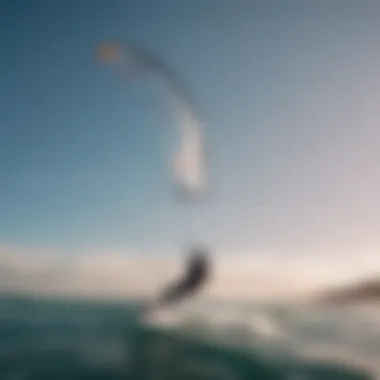
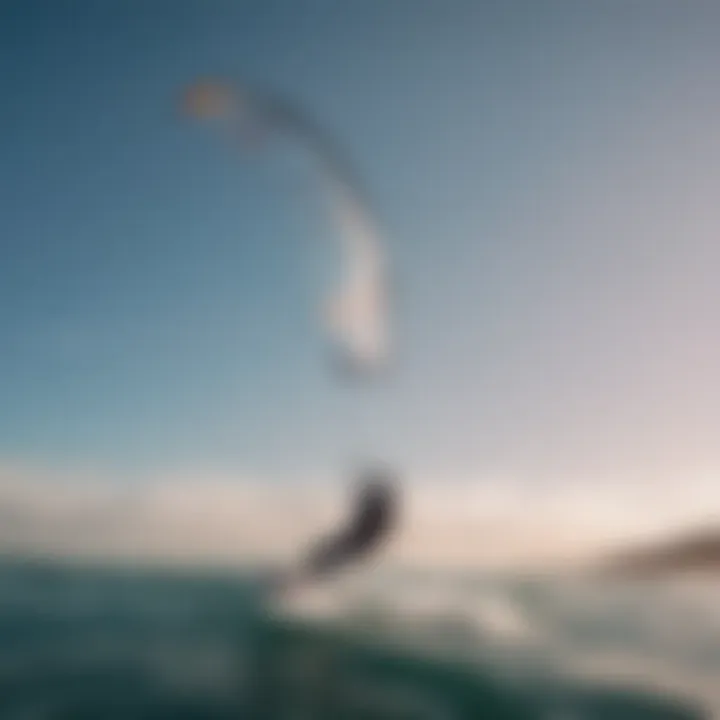
Comparison with Leading Edge Inflatable Kites
When comparing foil kites with leading edge inflatable kites, several key differences arise:
- Structure and Design: Foil kites have a soft structure with no rigid frame, relying instead on the air flowing within them to maintain shape. Leading edge inflatable kites, on the other hand, feature inflatable bladders that support the structure and help maintain a defined shape.
- Performance in Wind: Foil kites excel in lighter winds, offering better performance due to their efficient design. In contrast, leading edge inflatable kites may struggle in the same conditions but provide more stability in high winds.
- Portability: Foil kites are generally more lightweight and compact, making them easier to transport and store. In contrast, inflatable kites can be bulkier due to their construction.
- Learning Curve: Beginners may find leading edge inflatable kites easier to manage initially because of their stability in a range of conditions. Foil kites, while efficient, may require more experience to master due to their sensitivity to wind changes.
The differences between foil kites and leading edge inflatable kites are fundamental, influencing a kitesurfer's choice based on situational needs and preferences.
Design Characteristics of Foil Kites
The design characteristics of foil kites are essential to their performance and functionality in kitesurfing. Understanding these features helps kitesurfers make informed decisions and choose the right equipment for varying wind conditions and personal skill levels. Key aspects of design include structural elements, material composition, and the inflation mechanism, all of which work collaboratively to enhance the kite's aerodynamics and overall effectiveness.
Technical Aspects
Foil kites are engineered with precision to optimize their flight and responsiveness. Unlike traditional kites, these kites rely on air flowing through formed cells to create lift. Key technical features include the aspect ratio, number of cells, and wing shape. A higher aspect ratio generally improves performance in light winds but might sacrifice stability in stronger gusts. Kites with multiple cells enhance inflow and maintain shape, allowing for better control in challenging conditions. The contours and canopy shapes also influence drag and lift, which are critical for achieving maximum efficiency and speed on the water.
Material Composition
The materials used in constructing foil kites play a significant role in their durability, weight, and performance. Typically, high-quality nylon fabric is common due to its lightweight and strong properties. The stitching techniques, which include reinforcement at stress points, contribute to the kite's overall longevity. Some brands may incorporate ripstop fabric, which prevents tearing and enhances the kite’s lifespan. The use of lightweight materials allows for better performance, especially in low-wind scenarios. It is important for kitesurfers to pay attention to these material choices when selecting a foil kite to ensure they meet their individual needs at sea.
Inflation Mechanism
The inflation mechanism of foil kites is notably different from that of leading edge inflatable kites. Unlike inflatables, which require air to be pumped into chambers, foil kites remain uninflated and depend on the movement of air through their cells to maintain structure. During the launch, the pilot must ensure proper positioning to allow air to flow into the cells efficiently. This mechanism enables foil kites to remain lightweight. While this design allows for rapid deployment and responsiveness, it also means pilots must be conscious of wind conditions and kite positioning to utilize their full potential effectively.
To maximize the advantage of foil kites, users should understand the mechanics of how the design elements contribute to performance in various wind situations.
In summary, the design characteristics of foil kites play a crucial role in their operation and effectiveness. From technical specifications to the materials used in their construction and their unique inflation mechanisms, each aspect significantly influences overall performance. Knowledge of these traits empowers kitesurfers to choose and utilize their kites more effectively.
Advantages of Using Foil Kites
Foil kites present a unique set of advantages that distinguish them from other types of kites, such as leading edge inflatable (LEI) kites. Understanding these benefits is crucial for kitesurfers looking to optimize their experience on the water. As this segment unfolds, we will explore several key advantages that foils provide, focusing on their performance in light winds, efficiency and speed, as well as portability and storage.
Performance in Light Winds
One of the primary advantages of foil kites is their superior performance in light winds. Unlike traditional kites, foil kites are designed to be more efficient in lower wind conditions. They often have larger surface areas and can generate lift even when the wind is less than ideal for other kites. This characteristic allows riders to enjoy kitesurfing times when others might be unable to launch their kites.
- Higher Lift Capability: Foil kites can create significant lift due to their aerodynamic design, enabling them to soar effectively in weak breezes.
- Delayed Stall: Foil kites tend not to stall as quickly as LEIs, providing more control and a smoother ride in unpredictable wind. This can be especially advantageous for beginners who are still mastering the nuances of kitesurfing.
"The efficiency of a foil kite can transform a mediocre session into a noteworthy one, allowing riders to explore new locations with less wind."
Efficiency and Speed
Another significant advantage of foil kites lies in their efficiency and speed. The design of these kites minimizes drag, allowing them to glide swiftly across the water. This feature becomes apparent during a ride, where the power-to-weight ratio plays a critical role in performance.
- Optimized for Speed: Riders can achieve higher speeds more easily with foil kites, making them a compelling choice for those interested in racing or speed-oriented kitesurfing.
- Reduced Use of Power: Foil kites require less power to maintain momentum compared to traditional kites. This means that riders can enjoy longer sessions without expending as much energy, resulting in improved stamina and enjoyment.
Portability and Storage
Foil kites excel in terms of portability and storage. Their design allows them to be packed down into a compact size. This is particularly advantageous for travelers and those who have limited storage space.
- Lightweight and Compact Design: Many foil kites pack small and weigh less than LEIs, making them easier to transport in a backpack or a regular car trunk. This can be a game changer for those traveling to remote kitesurfing spots.
- Less Maintenance: Foil kites are less prone to damage than inflatable kites as they do not require air pressure to maintain their shape. This aspect can save significantly on maintenance efforts and costs, as users may find they do not have to repair leaks or other issues associated with buoyancy.
In summary, the advantages of using foil kites are extensive, particularly for light wind performance, speed, and user-friendly portability. These points illustrate why foil kites have garnered a loyal following among kitesurfers and extreme sports enthusiasts. As more riders discover these benefits, the popularity of foil kiting is expected to continue to grow.
Challenges and Limitations of Foil Kites
Foil kites offer unique advantages but also present specific challenges and limitations. Understanding these is crucial for kitesurfers of all levels. Recognizing these factors can influence the choice of equipment, training methods, and overall experience on the water. This section addresses two critical aspects: sensitivity to wind conditions and the learning curve for beginners.
Sensitivity to Wind Conditions
Foil kites are particularly sensitive to varying wind conditions. Unlike leading edge inflatable kites, which maintain structure even in light winds, foil kites can behave unpredictably when wind speeds fluctuate. This sensitivity arises from their design, where the shape and surface area are critical for performance. In lighter winds, a foil kite might struggle to generate enough lift, making it harder for a kitesurfer to stay aloft.
Moreover, strong winds can create a different set of problems. Foil kites are more prone to overflying, which can lead to rapid loss of control. It's essential for riders to continually assess wind conditions. Understanding how the kite will respond to changes in wind speed and direction is crucial.
"A significant understanding of one’s local wind patterns can enhance the experience significantly when using foil kites."
Kitesurfers should be prepared to adjust kite size and technique to adapt to wind conditions. Being aware that foil kites may require a more strategic approach can lead to better performance and safety.
Learning Curve for Beginners
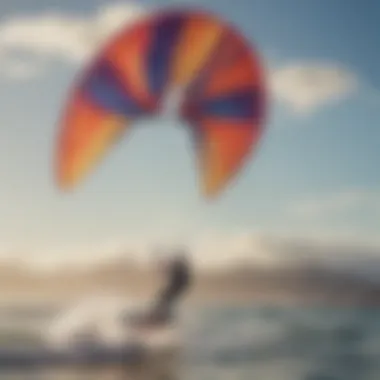
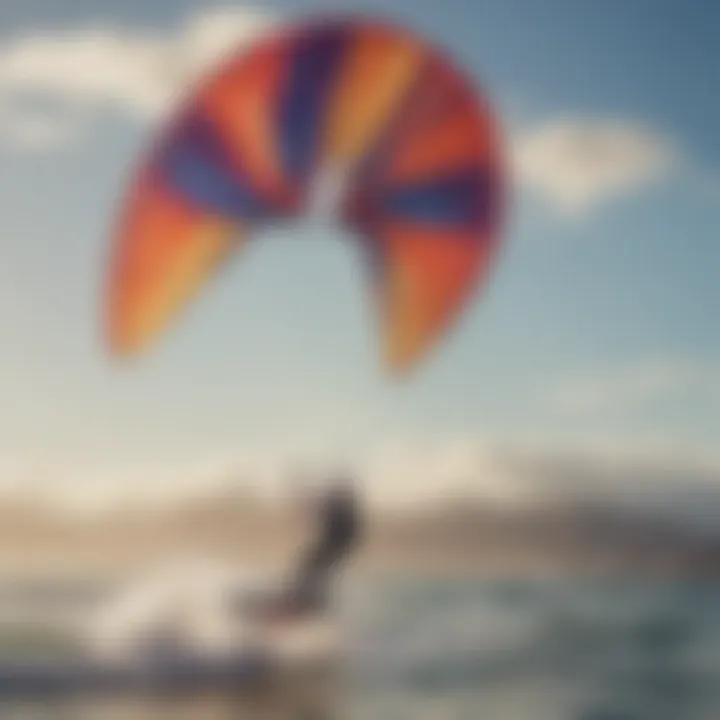
The learning curve associated with foil kites can be steep for beginners. New kitesurfers may find the mechanics of foil kites challenging, especially when compared to more conventional inflatable options. The responsiveness of foil kites demands a degree of finesse and awareness, which can often overwhelm novice users.
For beginners, mastering kite control, understanding how to properly launch and land, and adjusting to the kite’s performance in different conditions requires dedication. Take note of key learning aspects:
- Kite Control: Learning to handle the sensitive nature of foil kites is fundamental.
- Proper Launching Techniques: Accurate launching is crucial to avoid mishaps.
- Understanding Performance Limits: Recognizing what conditions are suitable for using a foil kite.
Given these challenges, it is advisable for beginners to invest time in learning from experienced kitesurfers or through structured lessons. Safety should always remain a priority. Identifying and rectifying poor technique early on can prevent unfavorable experiences. Investing in sufficient practice and knowledge enhances the rewarding experience of using foil kites.
Techniques for Mastering Foil Kiting
Understanding effective techniques for mastering foil kiting is crucial for both efficiency and safety. Mastery in these techniques can significantly enhance the kitesurfing experience, ensuring that riders harness the kite's full potential. Foil kiting demands a combination of precision in launching, navigation, and executing various maneuvers. Each of these elements plays a vital role in improving performance and minimizing mishaps. Therefore, gaining insight into these techniques is imperative for enthusiasts eager to elevate their skills.
Proper Launching Procedures
Launching a foil kite properly sets the stage for a successful session. The process begins with choosing an area clear of obstacles such as trees, buildings, and watercraft. Positioning the kite correctly is also important; it should be placed at the edge of the wind window to maximize lift upon launch.
Before launching, ensure that all lines are untangled and the kite is fully depowered. A quick check of the safety systems should be performed to confirm they are functioning adequately.
When ready, signal to your assistant (if available) to help with the launch. Start by gently pulling the back lines to initiate the kite's ascent. As the kite rises, maintain a steady tension on the lines to avoid luffing. This initial phase is critical; hasty movements can lead to loss of control or accidents. Practicing this procedure repeatedly will build muscle memory, enhancing both safety and confidence.
Navigation and Control Tips
Efficient navigation and control are imperative for smooth kitesurfing. First, understanding how wind direction and intensity affect kite behavior is key. Adjusting body weight and kite angle can help maintain speed and balance.
Riders should keep a firm grip on the control bar, ensuring both hands are equally engaged. For navigating, using subtle movements is better than drastic pulls. This allows for smoother turns and quicker adjustments in speed or direction.
In crowded or challenging conditions, awareness of surrounding sailors and obstacles is paramount. It is advisable to practice right-of-way rules, understanding that safety should always come first. Using visual cues and maintaining a clear line of sight can promote safer navigation.
Tricks and Maneuvers
Acquiring a repertoire of tricks and maneuvers can elevate the kitesurfing experience. Start with basic tricks, such as jumps and transitions. Mastering these forms the foundation for more advanced techniques.
Progressing gradually is essential. Tricks should be attempted only when comfort with the kite's handling is achieved. For instance, during jumps, timing becomes critical—the kite must be sent upwards just as the rider springs off the water.
Practicing in varying conditions can also develop adaptability. For example, executing a handle pass requires practice in both light and strong winds to understand how the kite reacts. This adaptability often translates into greater confidence on the water and enhances overall performance.
The combination of proper launching, navigation, and maneuvering techniques defines the foil kiting experience. Adequate practice establishes a solid foundation to build upon, fostering both progression and safety in the sport.
Safety Considerations in Foil Kiting
The importance of safety in foil kiting cannot be overstated. Engaging in this sport involves both skill and the potential risk of accidents caused by equipment failure or environmental factors. To mitigate these risks, establishing a comprehensive safety protocol is essential. This section discusses critical elements that every kitesurfer should consider, highlighting equipment safety checks and the importance of understanding weather conditions.
Equipment Safety Checks
Regular equipment safety checks are crucial for ensuring that your foil kite operates as intended. Kitesurfers should inspect their equipment before every session. This practice helps identify any potential issues that could lead to accidents. Here are some key checks to perform:
- Lines and Swivels: Look for any fraying or wear. Damaged lines can result in loss of control.
- Kite Fabric: Inspect the fabric for tears or punctures. Even small damages can compromise the kite's performance.
- Zippers and Velcro: Ensure zippers are functional and Velcro is secure. These components help maintain the kite's structure.
- Safety Leash: The safety leash must be in good condition and attached correctly. This mechanism is essential for preventing runaway kites.
By conducting these routine checks, you can enhance your safety and boost your confidence while kiting.
Understanding Weather Conditions
Weather conditions play a significant role in safe kiting practices. An accurate assessment of wind speed and direction, along with the overall environmental state, is vital. Kitesurfers should always check local forecasts before heading out. Some specific considerations include:
- Wind Speeds: Ideal wind conditions for foil kiting typically range between 10 to 20 knots. Knowing the upper and lower limits for your kite size is critical.
- Wind Direction: Understand how wind direction affects the launch and landing of your kite. Cross winds can be particularly challenging.
- Weather Changes: Be aware of sudden weather changes. Storms or increasing wind velocity can create hazardous conditions quickly.
"Understanding weather is as important as mastering your equipment. It can dictate your safety more than your ability to control the kite."
In summary, prioritizing safety in foil kiting involves diligent equipment checks and a keen awareness of weather conditions. By understanding these factors, kitesurfers can engage in their sport with greater confidence and control.
Maintenance and Care for Foil Kites
Maintaining and caring for foil kites is crucial for their longevity and performance. Proper care ensures that the kite works efficiently and safely while also enhancing the overall experience for the user. By addressing maintenance, kitesurfers can avoid unexpected issues on the water and achieve better performance in varying conditions. Additionally, knowledge about care practices can save money in the long run by reducing the need for major repairs or replacements.
Regular Cleaning Practices
Dirty kites can lose their efficiency and aerodynamics. Here are some key practices for cleaning foil kites:
- Rinsing After Use: Always rinse the kite with fresh water after each session. This practice removes salt, sand, and dirt which can degrade the materials over time.
- Gentle Soap Use: When deep cleaning is necessary, use a mild soap and a soft cloth. Avoid harsh chemicals that can harm the materials.
- Drying: Make sure to dry the kite completely before storing it. Moisture can lead to mold growth, which is difficult to remove and can damage the fabric and seams.
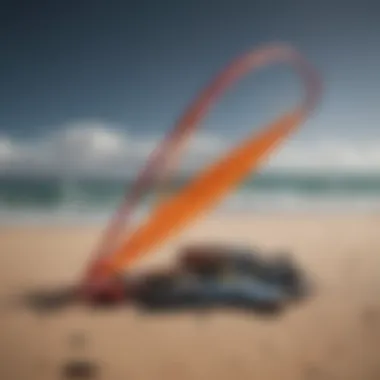
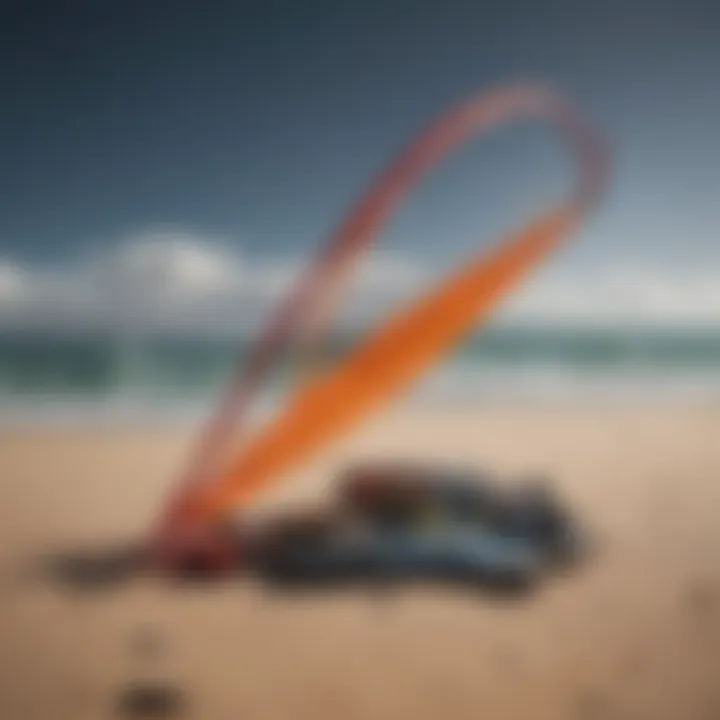
Regular cleaning not only maintains the appearance of the kite but also helps to keep it in optimal condition, ready for the next adventure.
Repairs and Troubleshooting
Despite careful use, issues can arise that need attention. Knowing how to repair common problems can greatly extend the life of a foil kite. Here are some critical points regarding repairs and troubleshooting:
- Identifying Damage: Inspect the kite regularly for any tears, loose seams, or damage to the leading edge. Early detection can prevent further issues.
- Using Repair Kits: Carry a kite repair kit, which typically contains patches, adhesive, and tools. This allows you to quickly address minor damages on the spot.
- Reinforcing Seams: If a seam begins to fray, reinforce it with tape or proper stitching. This prevents further deterioration and maintains the structural integrity of the kite.
- Seeking Professional Help: For significant issues, such as large tears or frame damage, seek professional repair services. This ensures the kite is restored properly and remains safe to use.
By understanding maintenance routines and repair procedures, kitesurfers can ensure their foil kites remain in outstanding condition, thus enhancing their overall kitesurfing experience.
Remember: Proper maintenance leads to better performance and greater safety on the water.
Popular Foil Kite Brands
In the realm of kitesurfing, the choice of equipment plays a pivotal role in ensuring performance and safety. Popular foil kite brands offer distinct advantages that can significantly enhance a kitesurfer’s experience. Understanding these brands not only helps in selecting the right kite but also provides insights into advancements in design and technology that enhance the sport.
Overview of Leading Manufacturers
Several manufacturers have made a mark in producing high-quality foil kites. Brands like Ozone, Naish, and Liquid Force are known for their dedication to innovation and quality. They are committed to offereing products that cater to various skill levels, from beginners to advanced riders.
- Ozone is recognized for its lightweight and efficient designs. Their kites are suitable for different conditions and offer excellent performance in light winds.
- Naish has a long-standing reputation in the kitesurfing community. They focus on versatility, allowing riders to use their kites across different water conditions.
- Liquid Force combines functionality with style. Their kites are designed to be both durable and visually appealing, attracting many kitesurfers.
Choosing from these popular brands enables a kitesurfer to tap into a wealth of experience and technological know-how. Each brand provides unique features and designs, which can cater to specific preferences and needs.
Innovations in Kite Design
The innovations in kite design from leading brands have transformed foil kiting over the years. These advancements include improvements in shape, materials, and trim options. For example:
- Altered Wing Shapes: Modern foil kites now feature altered wing shapes that increase lift and reduce drag. This enhancement allows for improved performance at lower wind speeds.
- Advanced Materials: Manufacturers are utilizing high-end materials such as ripstop nylon and mylar, which contribute to lighter weights and greater durability. This kind of material provides resistance to wear and tear, extending the life of the kite.
- Adjustable Trim Options: Innovations also include adjustable trim systems that let riders fine-tune their kites according to specific wind conditions. This functionality allows for better control, resulting in a more enjoyable riding experience.
"The advances in the kite design have reshaped the experience of foil kiting. It's not just about the ride; it's about harmony with the wind."
Community and Events
The role of community and events in the world of foil kiting is crucial. They serve as catalysts for learning, sharing experiences, and fostering connections among enthusiasts. For both beginners and seasoned kitesurfers, engaging with a community provides not only support but also motivation and inspiration.
Communities around kitesurfing often organize local meet-ups, training sessions, and social gatherings. These events allow participants to exchange tips and techniques, watch skilled riders, and absorb valuable insights. Group sessions can help particularly those new to foil kiting to boost their skills more rapidly than practicing alone.
Moreover, events like competitions play a significant role in the foil kiting world. They showcase the latest in kite technology and attract riders from various backgrounds, encouraging athletes of all levels to participate and experiment with different styles. The camaraderie built during these events strengthens bonds among participants, enriching the foil kiting culture overall.
Foil Kite Competitions
Foil kite competitions are an exciting aspect of the foil kiting community. These contests showcase the skills of riders while promoting new techniques and kite innovations. Competitions usually emphasize not just performance but also creativity in maneuvers and style.
For example, events like the Kite Freestyle World Cup have contributed to the evolution of foil kites. They help athletes to refine their skills in real-world settings, pushing the boundaries of what is possible on the water. These competitions motivate individuals to practice extensively and develop unique styles or tricks, further driving the progression of the sport.
In addition to skill development, participating in competitions can also create pathways for sponsorship opportunities. This encourages more riders to take part, resulting in a vibrant competitive scene where newcomers can find inspiration from established names.
Social Media and Forums
Social media platforms and online forums are vital for the foil kiting community. They have transformed how enthusiasts connect and share knowledge. Websites like Reddit, and Facebook groups dedicated to kitesurfing provide channels for discussion, advice, and updates on local events.
Through these platforms, experienced riders can offer support to beginners, tackling common questions and concerns. For instance, forums often feature discussions around troubleshooting, gear updates, and techniques which root deeper understanding.
Moreover, social media serves as a medium for showcasing talent. Riders often share videos of their sessions or competitions, which not only inspires peers but also allows for online feedback and improvement. Posts on these channels can foster debates regarding gear preferences or riding styles, helping individuals make informed decisions regarding their own kiting setups.
Engagement in online communities can help in forming local networks that enhance the kitesurfing experience as a whole, underscoring how pivotal community and events are in enriching the sport.
Closure
In any exploration of foiling, the concluding section holds significant weight. The importance of this section in the article cannot be overstated. Here, we consolidate the core themes discussed throughout, emphasizing the unique aspects of foil kites and their application in kitesurfing.
Future Trends in Foil Kiting
The future of foil kiting is promising, influenced by ongoing innovation in technology and design. Key trends are emerging which enthusiasts should monitor:
- Enhanced Materials: Manufacturers are focusing on lightweight and durable materials. This will improve performance while extending the lifespan of kites.
- Smart Kiting Technologies: Integration of smart technologies may become commonplace. These include GPS tracking and performance monitoring, allowing riders to modify techniques based on real-time data.
- Sustainability Practices: As environmental considerations grow, the kitesurfing industry is adopting sustainable practices. From sourcing materials to manufacturing, these efforts aim to reduce the carbon footprint.
These trends indicate a shift toward greater performance, safety, and sustainability in foil kiting.
Final Thoughts for Enthusiasts
For kitesurfing enthusiasts, especially those newer to the sport, the knowledge gained from this article provides a strong foundation. Foil kiting is not just about performance but also about the community and culture that surrounds it.
- Stay Informed: Continue to stay updated on innovations and best practices within the kiting community.
- Practice Responsibly: Understanding safety guidelines ensures enjoyable experiences for all participants.
- Engage with Community: Participate in local events and connect with other kitesurfers. These experiences provide invaluable insights and foster camaraderie.
In summary, as the sport evolves, remaining adaptive and curious is essential for continued enjoyment and mastery of foil kiting.







